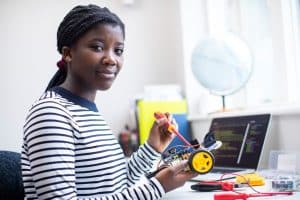Underwater Robotics: SeaPerch National Challenge
Dive into the ultimate underwater robotics competition: the SeaPerch National Challenge. Here, students innovate, build, and vie for the champion title in this exciting arena.
The SeaPerch National Challenge pushes students to design, construct, and operate underwater robots. As a national-level event, it gathers participants from across the United States, allowing them to showcase their engineering and technical prowess.
Engaging in this esteemed competition offers myriad benefits. It not only provides tangible experience with robotics and underwater exploration but also nurtures critical thinking, problem-solving skills, and team collaboration.
This competition is invaluable for both students and the broader STEM community. It offers a distinctive platform for budding engineers to hone their technical and creative skills while championing STEM education and related career trajectories. Through the challenge, students gain deep insights into the design, construction, and operation of remotely operated underwater vehicles (ROVs).
The program also allows students to work with mentors and experts in the STEM fields, further enhancing their learning experience.
SeaPerch National Challenge
The SeaPerch program is an innovative underwater robotics program that aims to engage students in STEM (Science, Technology, Engineering, and Math) learning through a fun and challenging competition.
The program was developed by the Society of Naval Architects and Marine Engineers (SNAME) and the Office of Naval Research (ONR) in 2003 and has since grown to become a widely recognized program with both regional and national competitions.
The concept of SeaPerch was developed in response to a need for an affordable and accessible underwater robotics program that could be implemented in schools across the United States.
The program was designed to provide students with a hands-on opportunity to learn about engineering, technical skills, and teamwork while also promoting STEM education and career paths.
The SeaPerch program is built around the construction and operation of remotely operated underwater vehicles (ROVs).
Since its inception, the SeaPerch program has grown significantly, with over 400,000 students participating in the program worldwide. The program has also expanded to include a range of events, including regional and national competitions, teacher training workshops, and outreach events.
The SeaPerch National Challenge, in particular, has become a highly anticipated annual event, bringing together top-performing teams from regional competitions to compete for the national championship.
Overall, the SeaPerch program has been instrumental in promoting STEM education and career paths, providing students with a unique opportunity to engage in hands-on learning and develop critical technical and teamwork skills.
With its history of innovation and impact, the SeaPerch program continues to be a vital program for students and the STEM community.
Structure of the Competition
The competition is structured in several phases, including regional and national competitions. The regional competitions occur across the United States and are open to middle and high school students.
These competitions are designed to identify top-performing teams that will advance to the national competition.
The first phase of the competition involves designing and building an ROV that meets the specifications provided by the SeaPerch program. The design requirements include specific materials and dimensions that must be met, as well as guidelines for the vehicle’s propulsion, control systems, and buoyancy.
Once the ROV is constructed, teams must test their vehicles in a pool to ensure that they meet the competition’s requirements. Teams must also provide documentation detailing their design process, including design drawings, calculations, and test results.
The second phase of the competition involves regional competitions. These events typically take place in the spring and early summer and involve a series of tasks and challenges designed to test the ROVs’ capabilities.
These tasks may include navigating through an obstacle course, retrieving objects, and performing tasks such as repairing an underwater pipeline or conducting research.
The top-performing teams from the regional competitions advance to the national competition, which takes place in the summer. The national competition includes additional tasks and challenges, as well as an awards ceremony that recognizes the top-performing teams.
In addition to the competition itself, the SeaPerch program provides a range of resources to support students and teachers. These resources include kits for building the ROVs, curriculum materials, and technical support from program staff.
The program also offers teacher training workshops and outreach events designed to promote STEM education and raise awareness of the SeaPerch program.
The program’s emphasis on STEM education and career paths helps prepare students for success in the 21st-century workforce, making it a valuable program for students and the STEM community.
What are the rules and regulations of the SeaPerch National Challenge?
What are the rules and regulations of the SeaPerch National Challenge? The competition is open to teams of students who meet the eligibility criteria and follow the rules established by the SeaPerch program.
Eligibility Criteria
- Age Requirements: The SeaPerch program is open to middle and high school students between the ages of 11 and 19. This includes students in grades 6 through 12 who are enrolled in a public, private, or home school.
- Team Size: Teams must consist of at least one student and may include up to four students. Teams must have a designated team captain who will be responsible for coordinating the team’s activities and communication with program staff.
- Educator Support: All teams must have a designated educator who will serve as the team’s mentor and provide guidance and support throughout the competition. The educator may be a teacher, coach, or other adult affiliated with the school or organization sponsoring the team.
- Registration and Fees: To participate in this prestigious and challenging competition, teams must register online and pay a registration fee. The registration fee covers the cost of the team’s SeaPerch kit, which includes all of the materials needed to build the ROV.
Format
This prestigious and challenging competition is divided into two parts: the Regional Challenge and the National Challenge.
The Regional Challenge is held in different regions across the United States, and the winners of each region advance to the National Challenge. Each team must compete in the Regional Challenge in order to qualify for the National Challenge.
Scoring
This includes a series of tasks and challenges that teams must complete using their ROVs. Each task and challenge is assigned a point value based on its difficulty, and the teams are scored based on their performance. The team with the highest score at the end of the competition is declared the winner.
Judging Criteria
In order to ensure fairness and objectivity, the SeaPerch National Challenge uses a team of judges to evaluate the teams’ performances.
The judges are experts in underwater robotics and are trained to evaluate the teams’ designs, construction, and performance. The judging criteria include the following:
- Design: Teams are evaluated on the design of their ROV, including the use of the SeaPerch kit, creativity, and functionality.
- Construction: Teams are evaluated on the quality of their construction, including the use of proper techniques and materials.
- Performance: Teams are evaluated on their ROV’s ability to complete the tasks and challenges in the competition, including speed, accuracy, and control.
- Sportsmanship: Teams are evaluated on their sportsmanship and behavior throughout the competition, including teamwork, communication, and respect for other teams and judges.
Rules and Regulations
This prestigious and challenging competition has a set of rules and regulations that all teams must follow in order to ensure fairness and safety. These rules and regulations include the following:
- Use of the SeaPerch Kit: Teams must use the SeaPerch kit to construct their ROV and are not allowed to modify the kit components in any way except as specified in the guidelines.
- Tether Length: The tether between the ROV and the control box on the surface must be no longer than 15 meters.
- Safety: Teams must follow safety guidelines established by the SeaPerch program, including wearing appropriate safety equipment and ensuring that all electrical components are properly grounded.
What are the benefits of participating in the SeaPerch National Challenge for students?
This prestigious and challenging competition provides an excellent opportunity for students to develop critical STEM skills such as engineering, design, and problem-solving.
In this blog, we will explore how participating in this prestigious and challenging competition can help students develop these skills and prepare them for future success in STEM-related fields.
1. Strong concepts in engineering
Students must use their knowledge of physics and engineering to design and construct their underwater ROVs. This requires a deep understanding of buoyancy, stability, and propulsion.
Students must use their creativity and ingenuity to build an ROV that is both functional and effective. Through the process of designing and building their ROVs, students develop a strong foundation in engineering concepts that can be applied to future projects.
2. Design
Design is another important skill that students develop through this prestigious and challenging competition. In order to create a successful ROV, students must consider factors such as size, weight, and materials.
They must also incorporate features that enable their ROVs to perform various tasks and challenges. Design thinking is a crucial aspect of this prestigious and challenging contest, as students must iterate and refine their designs in order to optimize performance.
3. Problem-solving
This requires students to think critically and solve complex problems. Throughout the competition, teams are presented with a series of challenges that require creative solutions.
For example, students may need to design an ROV that can navigate through a course while avoiding obstacles or one that can retrieve objects from the bottom of a pool.
These challenges require students to think outside the box and develop innovative solutions. This type of problem-solving is an essential skill in STEM-related fields, where finding solutions to complex problems is a daily occurrence.
4. Preparing for the future
The skills that students develop through the competition are highly sought after by employers in the STEM industry. The ability to design, build, and solve problems are critical skills for success in fields such as engineering, robotics, and computer science.
The SeaPerch National Challenge provides an opportunity for students to develop these skills early on and gain a competitive edge in their future careers.
5. Learning about Oceanography and Marine Science
As they build and operate their ROVs, students learn about the physics of water, the biology of marine life, and the importance of preserving our oceans.
They can also explore topics such as hydrology, ocean currents, and marine ecosystems. This knowledge is critical for understanding the impact of human activities on the ocean and for developing sustainable solutions to protect our planet’s natural resources.
6. Collaboration with peers
This prestigious and challenging competition encourages collaboration among students as they work together to design and construct their ROVs. They learn to communicate effectively, share ideas, and resolve conflicts, all of which are critical skills for success in any team environment.
Collaboration is particularly important in STEM fields, as many projects require teams of individuals with diverse skills and knowledge to work together towards a common goal.
Participating in this prestigious and challenging competition helps students develop these skills and prepares them for success in future collaborative environments.
7. Mentorship opportunities
It also provides students with mentorship opportunities. Mentors can come from a variety of backgrounds, including STEM professionals, educators, and older students who have previously participated in the competition.
Mentors can provide guidance and support to students as they navigate the design and construction of their ROVs, as well as offer insights into potential career paths in STEM fields.
Recognition and Awards
Participating in this prestigious and challenging competition not only offers students the opportunity to develop important STEM skills but also provides a chance to earn recognition and awards for outstanding performance.
Here, we will explore the different types of recognition and awards that students can earn through the SeaPerch National Challenge.
1. Regional and National Awards
One of the primary ways that students can earn recognition through this prestigious and challenging competition is by winning regional and national awards.
Regional awards are given to the top-performing teams in each region, while national awards are given to the best-performing teams at the national level. These awards recognize outstanding performance in areas such as design, construction, and performance of the ROVs.
2. Innovation Awards
These awards recognize teams that have demonstrated exceptional creativity and innovation in their ROV design and construction.
Students who earn innovation awards have typically gone above and beyond the basic requirements of the competition, developing unique and creative solutions to complex challenges.
3. STEM Education Awards
This also offers STEM education awards, which recognize outstanding contributions to STEM education by individuals, teams, or organizations.
These awards are given to those who have made a significant impact in promoting STEM education and inspiring students to pursue careers in STEM fields.
4. Scholarship Opportunities
In addition to recognition and awards, participating in this prestigious and challenging competition can also open up scholarship opportunities for students.
Many colleges and universities offer scholarships to students who have demonstrated exceptional performance in STEM competitions such as the SeaPerch National Challenge.
These scholarships can help offset the costs of higher education and provide students with opportunities for further learning and career development.
In conclusion, this prestigious and challenging competition is an incredible opportunity for students to develop important STEM skills, gain hands-on experience with robotics and underwater exploration, work collaboratively with peers and mentors, and earn recognition and awards for their outstanding performance.
Participation in this competition can also give students a significant edge in their college applications.
College admissions officers are always looking for students who have demonstrated exceptional creativity, innovation, and leadership skills, and participation in this prestigious and challenging competition is a great way to showcase those skills.
Winning awards and recognition in this competition can help students stand out from the crowd and demonstrate their potential for success in college and beyond.
Suppose you are a student interested in participating in the SeaPerch National Challenge or other competitions to leverage your college application. In that case, it’s important to start preparing early and seek out resources and guidance to help you succeed.
One great resource is AdmissionSight, a team of college admissions experts who can provide personalized guidance and support to help you navigate the admissions process.
We can help you develop a competitive application, identify your strengths and weaknesses, and create a strategy for success. We can also help you prepare for interviews, write compelling essays, and identify colleges and universities that are the best fit for your interests and goals.
So don’t hesitate to book an initial consultation with AdmissionSight today and take the first step towards achieving your college admissions goals!










































